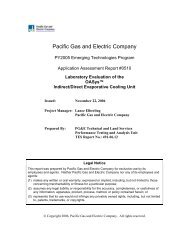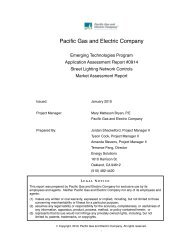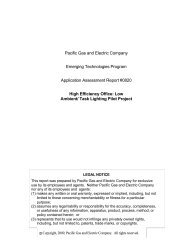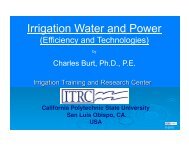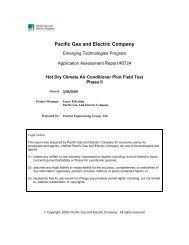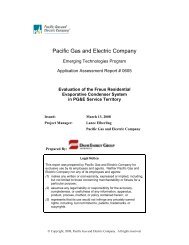Parking Lot LED Lighting Assessment Final Report - Emerging ...
Parking Lot LED Lighting Assessment Final Report - Emerging ...
Parking Lot LED Lighting Assessment Final Report - Emerging ...
You also want an ePaper? Increase the reach of your titles
YUMPU automatically turns print PDFs into web optimized ePapers that Google loves.
Page 13 of 15<br />
<strong>Parking</strong> <strong>Lot</strong> <strong>LED</strong> <strong>Lighting</strong> <strong>Assessment</strong><br />
Program Manager, U.S. Department of Energy, Building Technologies Program, in a recent article entitled “Lifetime<br />
Concerns”, when discussing how best to define the longevity of <strong>LED</strong> luminaires stated: “That’s not a simple matter,<br />
because it doesn’t just involve the <strong>LED</strong> themselves, but rather encompasses the entire system-including the power<br />
supply or driver, the electrical components, various optical components and the fixture housing.”<br />
In this project, the <strong>LED</strong> life is approximately 12 years. This results in the payback being achieved at approximately<br />
one half of the <strong>LED</strong> life, making this scenario an attractive alternative. This is an optimistic statement due to the<br />
unproven life of <strong>LED</strong> products and does not indicate that <strong>LED</strong>s are necessarily a viable option for all similar<br />
situations.<br />
Actual performance data documenting the life of <strong>LED</strong> luminaires does not yet exist due to the relative infancy of<br />
<strong>LED</strong> technology for general illumination applications such as parking structure lighting. While <strong>LED</strong> technology<br />
appears to be a viable option for parking lot lighting, <strong>LED</strong> product quality can vary significantly among<br />
manufacturers. Therefore, it is recommended that readers exercise due diligence when selecting <strong>LED</strong> technology<br />
for any application. Readers should also be aware that <strong>LED</strong> life and lighting performance are dependent upon<br />
proper thermal and electrical design. Without the latter, premature failure may occur. Readers must properly<br />
assess the potential risk associated with <strong>LED</strong> technology which has not undergone proper testing (i.e. LM 79, LM<br />
80). The DOE <strong>LED</strong> Application Series: Outdoor Area <strong>Lighting</strong> Fact Sheet contains Design and Specifications<br />
Considerations: http://apps1.eere.energy.gov/buildings/publications/pdfs/ssl/outdoor_area_lighting.pdf<br />
4. Life Cycle Cost Analysis<br />
Even though life cycle cost analysis was not part of the scope of this project, a full life cycle cost analysis is<br />
recommended. There are many variables and considerations which are specific to each reader’s situation. It is<br />
recommended that variables such as labor, cost of materials, maintenance practices, cost of financing, inflation,<br />
energy rates, material cost, product life, etc. be determined for the specific project under evaluation.<br />
Due to the uncertainty as to future labor, product and other costs, especially for <strong>LED</strong> technology, readers are<br />
recommended to use their judgment and do their own due diligence regarding the future costs. Due to the rapid<br />
advancements in <strong>LED</strong> technology, the pricing of the products may be reduced. Readers are encouraged to obtain<br />
current price quotes for <strong>LED</strong> luminaires as the <strong>LED</strong> market is in a state of flux. Furthermore, each project’s<br />
economic analysis will yield its unique set of results depending upon the project sponsors and site requirements.



